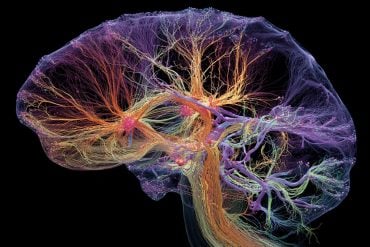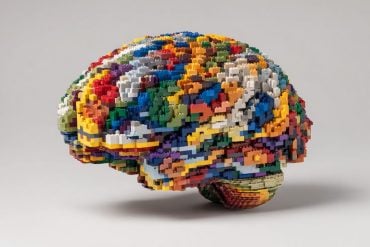Summary: Nasal injections comprising of platelet-rich plasma derived from a patient’s blood improve symptoms of smell loss associated with COVID-19 infection.
Source: Stanford
Early in the pandemic, when people with COVID-19 began reporting that they lost their sense of smell, Zara Patel, MD, figured as much. A professor of otolaryngology at Stanford Medicine, Patel has, for years, studied loss of smell as a symptom of viral infections.
“Many viruses can cause smell loss, so it wasn’t surprising to us as rhinologists when we found out that COVID-19 causes loss of smell and taste. It was almost expected,” she said. Patel also knew that the condition could last a while and that few effective treatments were available.
According to a 2022 survey by Patel and colleagues, about 15% of people who experienced smell loss from COVID-19 continued to have problems six months later. That’s roughly 9 million people in the U.S., and the number is growing. Many who report loss of smell also report loss of taste because smell is such a major component of how we experience food.
Now Patel’s team has tested a new treatment for long-term, COVID-19-related smell loss using injections of platelet-rich plasma derived from a patient’s own blood. In a trial of 26 participants, those who received the treatment were 12.5 times more likely to improve than patients who received placebo injections.
The study was published Dec. 12 in the International Forum of Allergy and Rhinology.
Platelet-rich plasma is a concentrated form of plasma, the liquid portion of blood, with blood cells and other blood components removed. It’s rich in platelets and, most importantly, growth factors—compounds known to help regenerate tissue. Platelet-rich plasma has been purported to treat mild arthritis when injected into joints, reduce wrinkles when used on the face, and even regrow hair when injected into the scalp.
Patel was skeptical of such a cure-all but was intrigued by a study showing that platelet-rich plasma injections were as effective as surgery in treating carpal tunnel syndrome, which is caused by compressing and injuring a nerve in the wrist. She knew that COVID-19-related smell loss also was a neurological problem, in which long-term effects of the virus prevent nerves deep in the nasal cavity from regenerating correctly. These nerves connect to the brain and normally regenerate every three to four months.
“It’s a nerve damage and nerve regeneration issue that we’re dealing with,” she said.
Stealth attack
The SARS-CoV-2 virus doesn’t target nerve cells directly; it attacks supporting cells known as sustentacular cells, which have the ACE-2 receptor the virus uses to infect cells. These cells play a role in correct nerve regeneration, so persistent inflammation and damage to these cells may lead to long-term loss of function.
Patel had already completed a small pilot study demonstrating the safety of platelet-rich plasma injections in the nasal cavity when the pandemic hit, so she pivoted her plans for a larger trial to focus specifically on COVID-19-associated smell loss.
All participants had confirmed past COVID-19 infections and persistent smell loss lasting between 6 and 12 months. They also had to have already tried other treatments such as olfactory training and steroid rinses.
“I wanted to make sure that whatever intervention I was going to study was not just in place of or equivalent to the treatments we’re already doing, but a benefit above and beyond,” Patel said.
Half the participants received platelet-rich plasma injections into the tissue deep inside their nasal cavity every two weeks for six weeks, while the other half received placebo injections (of saline) on the same schedule. Neither the participants nor the researchers knew who received what.
The sniff test
The researchers assessed smell ability using a standard olfactory test known as Sniffin’ Sticks. The test includes a range of odors, both pleasant (flowers) and terrible (rotten eggs), and participants are scored on their ability to identify the odors, tell odors apart and determine their strength, for a possible score of 48.
When the researchers checked in with the participants three months after their first injection, those in the platelet-rich plasma group scored on average 6.25 points higher than they did before treatment, which was 3.67 points greater than the placebo group. They gained most in their ability to tell different odors apart, known as smell discrimination. At three months, 57.1% of the platelet-rich plasma group had shown a clinically significant improvement, compared with just 8.3% in the placebo group.

Interestingly, when the participants rated their own smell ability, both groups reported similar improvement. Patel said that prior studies have found that subjective improvement doesn’t always match up with objective improvement.
The improvements in the placebo group could in part be due to a placebo effect, Patel said, but they could also suggest that some spontaneous recovery can happen even after six months.
COVID-19 has brought attention to post-viral smell loss, and perhaps more appreciation of the role smell plays in our daily lives, Patel said. Though this study did not evaluate taste loss, the recovery of smell likely also would help with recovery of taste.
“People tell me all the time that they never realized how important their sense of smell and taste was to them and their quality of life until they lost it,” she said. “People say, “My life has gone gray.'”
Patel is now offering platelet-rich plasma injections to patients outside the trial.
“Our olfactory systems can be resilient,” Patel said. “But the sooner you perform some sort of definitive intervention, probably the better chance you have of improvement.”
About this COVID-19 research news
Author: Nina Bai
Source: Stanford
Contact: Nina Bai – Stanford
Image: The image is in the public domain
Original Research: Open access.
“Use of platelet‐rich plasma for COVID‐19–related olfactory loss: a randomized controlled trial” by Carol H. Yan et al. International Forum of Allergy & Rhinology
Abstract
Use of platelet‐rich plasma for COVID‐19–related olfactory loss: a randomized controlled trial
Introduction
The current study evaluated the use of platelet-rich plasma (PRP), an autologous blood product with supraphysiologic concentrations of growth factors, in the treatment of prolonged coronavirus disease 2019 (COVID-19)–related smell loss.
Methods
This multi-institutional, randomized controlled trial recruited patients with COVID-19 who had objectively measured smell loss (University of Pennsylvania Smell Identification Test [UPSIT] ≤ 33) between 6 and 12 months. Patients were randomized to three intranasal injections of either PRP or sterile saline into their olfactory clefts. The primary outcome measure was change in Sniffin’ Sticks score (threshold, discrimination, and identification [TDI]) from baseline. The secondary end point measures included responder rate (achievement of a clinically significant improvement, ≥5.5 points TDI), change in individual TDI olfaction scores, and change in subjective olfaction via a visual analog scale.
Results
A total of 35 patients were recruited and 26 completed the study. PRP treatment resulted in a 3.67-point (95% CI: 0.05–7.29, p = 0.047) greater improvement in olfaction compared with the placebo group at 3 months and a higher response rate (57.1% vs 8.3%, odds ratio 12.5 [95% exact bootstrap confidence interval, 2.2–116.7]). There was a greater improvement in smell discrimination following PRP treatment compared with placebo but no difference in smell identification or threshold. There was no difference in subjective scores between PRP and placebo. No adverse effects were reported.
Conclusion
Olfactory function following COVID-19 can improve spontaneously after 6 months and can improve to a greater extent with PRP injection. These data build on the promise of PRP to be a safe potential treatment option for patients with COVID-19–related smell loss, and larger-powered studies will help further assess its efficacy.






